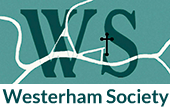Rowley Streatfeild Atterbury was born in Eastbourne in 1920. He left school at seventeen and volunteered to join the Royal Air Force, where he trained in engineering from 1938. A 1940 medical prevented him from becoming a fitter-armourer so he transferred to a section writing and supervising the production of technical manuals for the Air Ministry. On leaving the RAF at the end of the war Atterbury found work as a print manager for Faber and Faber in Russell Square, London.
By then living in Westerham, he spent weekends experimenting with a small printing press in ‘the chicken-shed’, a large lock-up in Buckham Thorns rented from his aunt, Sylvia Streatfeild. This was to become the beginning of a local printing works… The story is revealed in his obituary in The Times in 2011.
In 1950, the first year of trading on the new consolidated site, turnover had amounted to £3,819, in the financial year 1959-60 turnover had increased twenty-fold, to £63,488 and by 1969-70 had rocketed to £924,000.
Success was undoubted, but the innovative drive of Atterbury would lead to the undoing.
Rocappi
In 1964, Westerham Press was encouraged by arts and education philanthropist Max Rayne to investigate the latest developments in print technology, including a possible use of data processing in typesetting… A development team was assembled, headed by British mathematician Colin Barber, and the Press invested in the latest computer technology available at that time. A company named Rocappi (Research On Computer Applications to the Print and Publishing Industries) was formed, jointly owned by the Hazell-Sun Group (later to become the Watford-based British Printing Corporation), Rocappi Inc. of Swarthmore, Pennsilvania and the Westerham Press. A factory was leased at Otford, and under Barber’s guidance Rocappi developed methods of using computers to sort and analyse data related to text, and establish the first computer typesetting plant in Europe.
Several interesting projects were produced under ‘production conditions’ at Rocappi including a 12 volume set of Dents Everyman Encyclopaedia, The Imperial Calendar, the World Crops Directory, the Philips Record Catalogue, the Goldsmiths’ Catalogue, the compendium of Dylan Thomas Poems, the Stationary Trade Reference Book, the Fairplay Supplement, The Bible and many novels.
Expensive pioneering development is often subjected to financial pressures at too-early a stage to prove financial viability, and for Rocappi at Otford the commercial pressures were too great – Rocappi Inc. pulled out in 1967 and the Westerham Press shareholding was bought by the British Printing Corporation. Now the major stakeholder, BPC proceeded to dismiss the staff, including Atterbury and Barber, and by the end of January 1968 it was all history.
The demise of a dream
By the early 1970s the major shareholder of Westerham Press was London Merchant Securities, but on April 1 1972 then owners of Westerham Press bought-out the LMS shareholding, regaining control of the company under the Chairmanship of the unique publisher George Rainbird. By 1980 the Press had been divided in three separate disciplines – fine art, reports and accounts and general printing. Turnover was in excess of £5 million, but by 1984 it was all over – Westerham Press as a company was sold to printers and publishers St Ives Group and moved to a factory in Fircroft Way, Edenbridge. Within a short space of time, the Westerham factory was demolished and the land sold for housing.
Retrieval
Hurtwood Press
After the sale of Westerham Press, Rowley Atterbury set up Hurtwood Press with a group of close friends. Hurtwood published a limited edition book, ‘John Piper’s Stowe’ and then ‘A Golden Adventure: The First Fifty Years of Ultramar’ in 1985. A book of war drawings by Edward Bawden was planned but never published. Today, Hurtwood Press is a fine art printing consultancy, run as a partnership between Rowley’s son, Francis Atterbury and Jo Hilton. It produces books for specialist publishers, and work for artists, printers, and galleries.
The Hand Press
In a letter to Derek Nuttall, Rowley Atterbury wrote that when he sold Westerham Press in 1984, he saved as much of the older equipment as he could. The Hand Press was set up at Westerham Heights Farm and work provided for several members of staff who had been made redundant. The equipment saved included a Heidelberg Cylinder, a Heidelberg Platen, plus a vast Monotype collection.







No Comments
Add a comment about this page